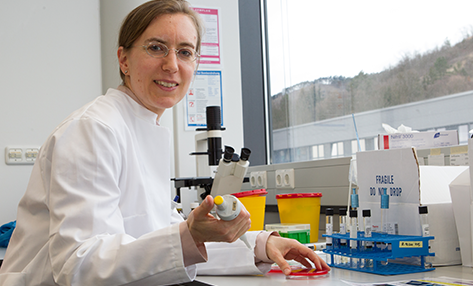Staphylococcus aureus is a bacterium that colonizes the nasopharynx of many healthy people. Approximately one third of the population is colonized with S. aureus. Colonization can be the cause of a serious infection such as pneumonia. Different isolates of S. aureus are in part very distinct from one another in their virulence factors. These factors include, for example, toxins which are produced from bacteria. Not enough is currently known about which individual factors and which combinations of factors are involved in the development of diseases.
Detection of S. aureus is done by taking a sample from the patient's nasopharynx. Today a positive test does not lead to treatment because the physician does not know if colonization will lead to an infection or not. 'This is a diagnostic problem – especially in immunocompromised patients who are susceptible to infections such as pneumonia,' says Professor Löffler. Expensive and debilitating antibiotic treatment is started primarily for patients with S. aureus strains which are methicillin-resistant (MRSA strains), in other words strains which are resistant to all ß lactam antibiotics, like penicillin. The need for this type of treatment currently cannot be accurately assessed.
Professor Löffler explains, 'Within the scope of the Campus sub-project titled "Determining the virulence of Staphylococcus aureus ", we want to identify the virulence patterns which make an infection with S. aureus likely so that we are in a better position to make a reliable diagnosis.' The virulence of a particular strain is determined by the synergy of many factors. According to Löffler, 'a more exact analysis of these factors and their effects will serve as the basis for developing a testing system.'
Together with her team of six colleagues, she is characterising RNA molecules of S. aureus isolates from patients with pneumonia (transcriptome analysis) for this purpose. The proteins which can form from S. aureus isolates are quantitatively determined with proteome analysis, which is also being used. Conclusions can be drawn about the virulence factors which cause pneumonia when they are compared to the isolates of healthy patients. For over 10 years, Professor Löffler has been investigating the virulence factors of S. aureus, especially the toxins and the way the bacteria works in the host. Löffler adds, 'Within the scope of the Campus research project, we have the opportunity to concentrate on a particular infection. We are primarily interested in determining which "toxic cocktail" causes pneumonia.'
The recruitment of a cohort of immunosuppressed patients and creation of an InfectoGnostics pathogen biobank forms the basis of her work in the InfectoGnostics Project. Only with them can a sufficient number of samples be taken and determined. This is also taking place within the Campus project. The development of a testing system based on this principle, which distinguishes between colonized S. aureus strains from strains that lead to infection, makes it possible to optimise current treatment options. Löffler explains, 'We can significantly improve the clinical diagnosis of pathogens in pneumonia and rapidly test their resistance levels when testing is done in combination with using a rapid diagnostic test for detecting multi-resistant gram negative bacteria, which is also being developed within the framework of the project'.
Professor Löffler is also carrying out a colonization study within the scope of the project. In this study, Löffler is investigating how high the colonization rate for S. aureus is in children living in Jena in comparison to the rate in adults, and the colonizing strains are analysed more closely. This information is very important for developing guidelines for determining when decolonization measures should possibly be taken in some patients prior to being admitted to the hospital or before they undergo surgery.
